Tyler F.M. Edwards's Blog, page 58
December 11, 2015
Poll: Would You Answer Polls on Superior Realities?
Sometimes I think about adding polls to posts to gauge people’s opinions on matters, or perhaps to help make decisions on future blog topics or the like. But I had always assumed I don’t really have enough followers to get a sample size worth paying attention to.
 I’ve decided to put that theory to the test. Depending on how many people bother to answer this poll, I might start adding them to posts in the future. Though I also reserve the right to wander off and lose interest in the idea without warning.
I’ve decided to put that theory to the test. Depending on how many people bother to answer this poll, I might start adding them to posts in the future. Though I also reserve the right to wander off and lose interest in the idea without warning.
If nothing else, this might be a good way to get an accurate read on what kind of readership I actually have. Right now the metrics available to me are all telling very different stories.
Filed under: Misc. Tagged: Off topic, polls, Why not Zoidberg?








December 8, 2015
Get Swag with my Heroes of the Storm Referral Link
I am upset.
From the very beginning, the one mount I have most wanted in Heroes of the Storm was a vulture hoverbike from StarCraft. Now it’s finally been released… as a reward for the newly launched recruit-a-friend program.
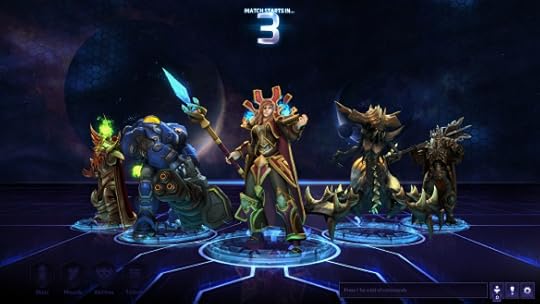 As someone with few gaming friends, I am now in a conundrum. I must have this mount. This is where you come in.
As someone with few gaming friends, I am now in a conundrum. I must have this mount. This is where you come in.
Help me, blogosphere, you’re my only hope.
If you want to give Heroes of the Storm a try, please use my referral link: https://battle.net/recruit/78ZHCGZ5GP
Being recruited in this manner will grant you instant and permanent access to everyone’s favourite space cowboy, Jim Raynor. He’s one of the easiest heroes for new players to pick up, so he’s a good starting point.
You’ll also get a five day stimpack, which increases your experience gains by 100% and gold gains from matches by 150%. Excellent way to hit the ground running.
If you reach account level ten after being referred (which is very easy to do), you will also unlock an exclusive recruit-a-friend portrait for your account, as well as permanent ownership of the Banshee Queen, Sylvanas Windrunner, a powerful specialist who can also deal ruinous damage to other heroes.
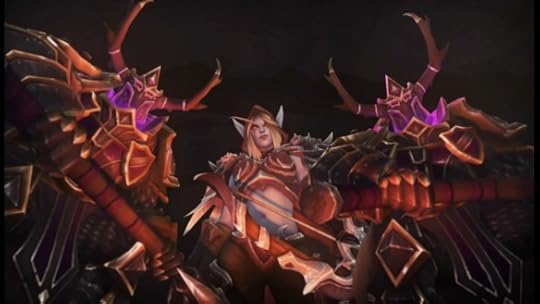 If you’ve already tried Heroes of the Storm, you may still be eligible for recruitment as long as you haven’t played for too long. Anyone up to and including account level five is eligible for recruitment.
If you’ve already tried Heroes of the Storm, you may still be eligible for recruitment as long as you haven’t played for too long. Anyone up to and including account level five is eligible for recruitment.
I’ve been max level in Heroes of the Storm since the technical alpha, have played all currently released heroes to at least level five (except Lost Vikings), and have three heroes at or above level ten (Jaina, Tassadar, and Sylvanas), so if you have any questions or want any newbie tips before jumping into Heroes, don’t hesitate to ask me in the comments.
Please note that since I play on the Americas server, you will also need to do so in order for either of us to be eligible for any recruitment rewards.
This recruitment program is not time limited, so even if you stumble across this post six months from now, you’ll still be able to reap the rewards of my referral link.
However, speaking of limited time offers…
Something salesy about there never having been a better time to try the game:
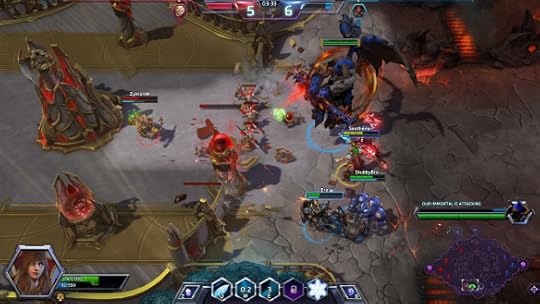 To celebrate the launch of the recruit-a-friend program, Heroes of the Storm is holding a 50% bonus experience week from now until December 16th. This will stack additively with the stimpack you get from the referral link for a total of 150% bonus XP from all sources, including versus AI matches.
To celebrate the launch of the recruit-a-friend program, Heroes of the Storm is holding a 50% bonus experience week from now until December 16th. This will stack additively with the stimpack you get from the referral link for a total of 150% bonus XP from all sources, including versus AI matches.
I wouldn’t be surprised if they rolled out another bonus XP event sometime around Christmas and/or New Years, either.
They’re also extending their Black Friday sale until the end of the year, which means 50% off everything in the store (including anything released during this month). So that’s cool, too.
On top of all that, today’s patch has also increased the free hero rotation from seven to ten heroes going forward, so you’ll have far more options for trying new heroes, as well as leveling them up for bonus gold.
Futhermore, talent-gating by account level has been permanently removed, meaning you will have no limits on how to build your heroes regardless of your level.
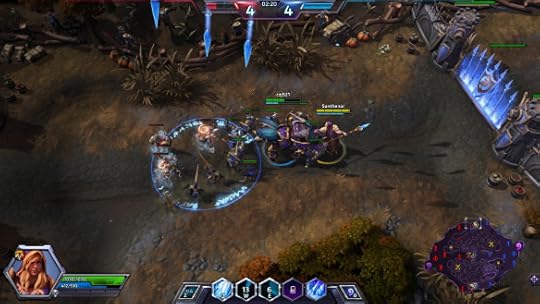 I don’t want to whore myself too much here, but this is an excellent game, and with all the events going on right now, this is a very good time to join, and please use my referral link I want that vulture mount so bad.
I don’t want to whore myself too much here, but this is an excellent game, and with all the events going on right now, this is a very good time to join, and please use my referral link I want that vulture mount so bad.
* * *
While we’re at it, I also have about a bajillion buddy keys for The Secret World if anyone has yet to try this truly amazing game. Send me a message through my contact page if you want one.
Filed under: Games Tagged: fantasy, Heroes of the Storm, sci-fi








December 7, 2015
Elder Scrolls Online: Digging Deeper
I’m continuing to (slowly) work my way through Elder Scrolls Online. I still mostly stand by my initial thoughts on it — it’s firmly in the “okay, not great” category — but it is at least continuing to hold my attention, and in some ways it’s growing on me.
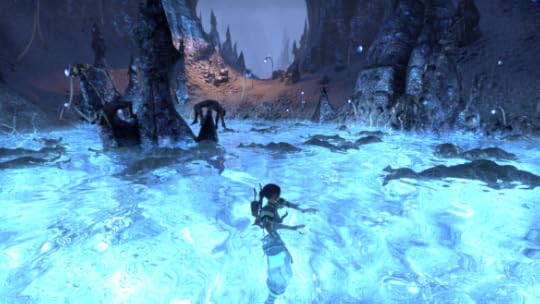 I credit a good chunk of this to the fact that the combat did become more challenging after a while. It’s still not particularly difficult, but at least it’s no longer a case of enemies falling over after two or three hits. And as I mentioned in a previous post, unlocking weapon swapping and a mount helped a lot, too.
I credit a good chunk of this to the fact that the combat did become more challenging after a while. It’s still not particularly difficult, but at least it’s no longer a case of enemies falling over after two or three hits. And as I mentioned in a previous post, unlocking weapon swapping and a mount helped a lot, too.
As I’ve progressed, I’ve been able to delve deeper into the game, and there are a few areas that stand out as worth discussing.
Crafting:
I normally don’t pay much attention to crafting in MMOs. I like the idea of it, but in practice it’s always far too much grinding for far too little reward. However, when I saw that ESO’s crafting was a little more in-depth than the average WoW clone, I decided to give crafting a try once again.
It’s been a bit up and down. I’ve nearly quit a couple times, but now I think I’m getting the hang of it.
Even with the crafting hirelings, I find I’m having trouble getting enough materials. It’s really making me dislike this game’s baffling insistence on not having an auction house.
 I’m also not entirely fond of the need to sink skill points into crafting — potentially a lot of them if you want all the perks. My understanding is that by endgame I’ll have more skill points than I know what to do with, but at low levels, I need all the points I can get, and with the glacial leveling pace in this game, spending one on non-combat skills always stings a bit.
I’m also not entirely fond of the need to sink skill points into crafting — potentially a lot of them if you want all the perks. My understanding is that by endgame I’ll have more skill points than I know what to do with, but at low levels, I need all the points I can get, and with the glacial leveling pace in this game, spending one on non-combat skills always stings a bit.
I also found that — as with crafting in most other games I’ve played — anything I made was still quite inferior to whatever random drops I got from questing, but I’m starting to think this may be my own error.
I’m used to the WoW model of crafting, where you just make a piece of gear and that’s it. I didn’t give much thought to researching and adding traits, or upgrading crafting pieces beyond white quality, or enchanting. So of course everything I made sucked.
Now that I’m taking those things into account, I’m actually able to make some gear that’s worth equipping.
Now I really regret not taking up enchanting…
I’m also making sure to deconstruct most of the gear I pick up, rather than vendoring it, as that seems to be a pretty good source of crafting XP. That makes me less reliant on crafting gear to level up, which somewhat lessens my material-starvation.
 I’m still making up my mind on crafting in ESO, but I’ve always liked the idea of self-sufficiency, of building my own equipment rather than kneeling at the altar of RNGesus. And it seems especially appropriate for a Bosmer huntress to live off the land. So if I can make it work, I will.
I’m still making up my mind on crafting in ESO, but I’ve always liked the idea of self-sufficiency, of building my own equipment rather than kneeling at the altar of RNGesus. And it seems especially appropriate for a Bosmer huntress to live off the land. So if I can make it work, I will.
It also gives me some control over the appearance of my gear, though I’m still struggling to find anything I like the look of. The lack of a transmogrification or wardrobe system in this game is a tad baffling. And while we’re at it, what’s with the lack of a barbershop?
Realizing I had the same hairstyle as Lyris Titanborn just sucked the fun out of it somehow…
Dungeons:
Dungeons seem to be a lost cause.
I just can’t find groups. For several days, I joined the queue for the first dungeon each time I played, but even after hours of play, the queue never popped. Only once was I placed in a group, and it went nowhere. The tank left immediately for reasons known only to them, and the healer bailed shortly thereafter. After about twenty minutes, we got another tank, but a replacement healer never showed, and eventually everyone gave up.
I hate forming groups through chat channels, and even if I didn’t, hardly anyone seems to be forming groups for low level content.

We just sat like this for half an hour.
The game seems pretty busy, so I wouldn’t think it’s a population issue. Do people in ESO just not care about dungeons?
I’ve thought about taking up healing in the hopes of improving my queues, but I’m not sure I want to spend some of my precious skill points on something I may not get any use out of.
I wasn’t exceptionally keen on doing dungeons in this game to begin with, so it’s not the end of the world. Bit of a shame, though.
The world:
ESO is for the most part a solid game, and while it does have some significant moments of frustration (as discussed above), I am enjoying myself a fair bit.
What I’ve been struggling to understand is why. Yes, it doesn’t give a lot of cause for complaint, and most it is at least solid, but as I’ve said from the beginning, there’s little that blows me away, either. The story is decent enough to keep me going, but certainly nothing special. My opinion of the combat has improved significantly, but it’s no TSW or Neverwinter.
I think I’m narrowing it down, though: It’s the world.
 ESO’s world is very detailed, and there are a lot of subtle things that make exploring it a more engaging experience than you’d find in the average MMO. I initially had my doubts about the policy of just leaving quests out in the world with no real clues as to their existence until you stumble across them, but I find it’s actually a lot of fun to try to hunt them down. They’re spaced pretty evenly across the map, so it’s not like you’re combing the countryside endlessly in the hopes of finding a quest or two.
ESO’s world is very detailed, and there are a lot of subtle things that make exploring it a more engaging experience than you’d find in the average MMO. I initially had my doubts about the policy of just leaving quests out in the world with no real clues as to their existence until you stumble across them, but I find it’s actually a lot of fun to try to hunt them down. They’re spaced pretty evenly across the map, so it’s not like you’re combing the countryside endlessly in the hopes of finding a quest or two.
Even if you’re not finding a quest — or a delve, or some other structured activity — exploring is rarely fruitless. The world is chock full of hidden loot, lore books, treasure chests, crafting nodes, and the like. It almost calls to mind the addictive wanderlust Guild Wars 2 once inspired in me.
Exploring is something I rarely enjoy in MMOs, but that’s because it’s so rarely made to be worth your time. When there’s something to the activity other than wandering without aim, it’s quite a joy.
Then there are pleasant little touches like ambient dialogue that reflects your actions, random NPC conversations, and most of all the weather.
I’ve played plenty of video games with weather, but none have come anywhere near the realism of ESO (except maybe FFXIV). It’s pretty special to be able to look up at the sky in a video game; think, “Hmm, looks like rain soon”; and be caught in a downpour ten minutes later.
 I don’t get why there are random skeletons absolutely everywhere, though. Did the Orochi Group try to open a Tamriel branch?
I don’t get why there are random skeletons absolutely everywhere, though. Did the Orochi Group try to open a Tamriel branch?
The lore:
Something else that’s been interesting for a story nut such as I is getting to know the lore and history of the Elder Scrolls setting, which I’ve not had any significant exposure to before.
I know there are a lot of rabid fans of the Elder Scrolls lore, but I don’t think I’m going to be one of them any time soon.
The game’s story itself is adequate at best, and the many books of lore and backstory scattered around are mostly too dry even for me, seeming to favour wacky uber-fantasy names and an excessive amount of detail over actual depth or compelling content.
That’s not to say the lore is terrible. It’s just mediocre.
In fairness, my understanding of the lore is still quite incomplete, and I’m struggling to piece things together as I go, so that might not help. I will say ESO does a pretty good job, all things considered, of not making me feel overwhelmed as a newcomer to what is clearly a vast and intricate mythos.
 And there are few things about the Elder Scrolls setting I’m developing a definite fondness for. Namely Bosmer and Khajiit.
And there are few things about the Elder Scrolls setting I’m developing a definite fondness for. Namely Bosmer and Khajiit.
No one who knows me should be surprised I’ve taken to Bosmer like a fish to water. Crazy, tribal, cannibal Elves? Sold!
I do think they’re a great middle ground between new and old ideas. They have enough elements of the traditional Elf archetype to feel familiar, but enough changes to feel fresh.
I like their feral, chaotic nature, as well as their irreverent sense of humour. It’s especially amusing when contrasted with the stuffiness of the Altmer.
Khajiit, on the other hand… They’re a cheap thrill, but an effective one. My impression to date is that there isn’t a lot of depth to them, in terms of individual characters or their culture as a whole, but their goofy speech pattern and roguish charm are pretty hard not to appreciate.
Again, they’re a delightful contrast to the holier-than-thou, aristocratic Altmer. On the whole, the Aldmeri Dominion is a very fun odd couple situation (odd trio, I guess), and I think I chose my faction wisely.
Filed under: Games Tagged: Elder Scrolls, fantasy, The Elder Scrolls Online








December 4, 2015
Gaming: Is It Worth It to Stand on Principle?
As gamers, we don’t have a lot of ways to make our voices heard by publishers and developers. We can try posting on forums, but unless it’s an indie game, we’re just one voice among many thousands, and what we say will count for little in the eyes of the developers — if they’re bothering to listen at all.
 That leaves voting with our wallets as the only reliable way to make our opinions count, at least in most cases. If a game company makes decisions we don’t agree with, we move on and take our money with us.
That leaves voting with our wallets as the only reliable way to make our opinions count, at least in most cases. If a game company makes decisions we don’t agree with, we move on and take our money with us.
But is that ever really worth it? Are we sending a message, or only hurting ourselves?
Diablo and DRM:
The best example I can think of is the group of people who flatly refuse to play Diablo III because of its always online nature (which, for the record, I agree is bad).
I’ve never quite grasped the logic of this. “I’m upset that I will only be able to play this game 97% of the time, therefore I will play it 0% of the time. That’ll show ’em.”
It just seems like cutting off your nose to spite your face.
And it’s a real shame, because the people who refuse to play D3 for this reason are missing out on what has evolved into a very good game. Living your whole life without experiencing the joy and wonder of Covetous Shen is simply tragic.
 There are also those who refuse to have anything to do with Steam because it is technically a form of DRM. I can only imagine the self-inflicted Hell that trying to be a PC gamer without Steam is in this day and age.
There are also those who refuse to have anything to do with Steam because it is technically a form of DRM. I can only imagine the self-inflicted Hell that trying to be a PC gamer without Steam is in this day and age.
And it really doesn’t seem to be making difference. Steam is an unstoppable institution, and Diablo III is one of the highest selling video games of all time.
I’m not entirely immune to this myself. I avoided playing World of Warcraft for most of the Warlords of Draenor expansion in protest over many poor decisions, most notably the lack of flying, and I’ve refused to touch Star Wars: The Old Republic due to its atrocious free-to-play model despite kind of wanting to see how the Imperial agent storyline plays out.
And neither of those decisions has done much good, either. Blizzard did step back from the removal of flight, and that might have been due to the mass subscription losses WoD suffered, but the WoW community is of such scale my own contribution to that, if any, must be minuscule to the point of irrelevance. SW:TOR, too, continues to enjoy great success despite the endless (and justified) hate its business model receives. The Star Wars IP is a license to print money.
Those were both easy decisions, too. I didn’t have much interest in Warlords of Draenor in the first place, and class story awesomeness aside, my feelings on SW:TOR have traditionally been lukewarm at best. Obviously, if you’re just not enjoying a game, it makes sense to stop playing it.
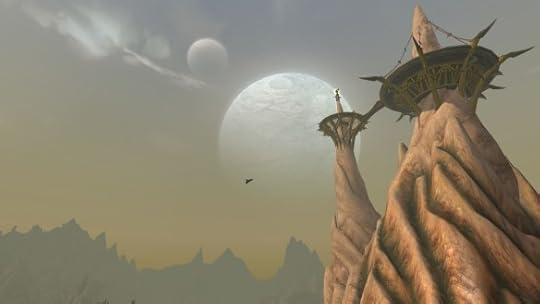 But what happens when there’s a game you really want to play despite having some big objections?
But what happens when there’s a game you really want to play despite having some big objections?
The Empire and the Legion:
This has been on my mind lately because I find my “principles,” such as they are, are coming into conflict with what I want to play, and again, it comes back to WoW and SW:TOR.
Despite myself, I’m getting somewhat excited for Legion. It’s not all good news, but there’s a lot of stuff coming that interests me, and if nothing else, I think it can at least return to WoW’s traditional two steps forward, one step backward approach — as opposed to WoD’s “two steps backward then three into the ditch and flail around like a beached whale” approach.
But I’m still pissed about flying. I consider it a core feature of WoW at this point, so not having it in at launch basically means the expansion will be launching unfinished. I generally make it a policy not to pay for unfinished products.
Similarly, as I’ve discussed in previous posts, I really like what I’m hearing about SW:TOR’s Knights of the Fallen Empire expansion, and despite my ambivalence towards Star Wars in general, I’m really tempted to give the game another shot (third time’s the charm, perhaps). But I really don’t want to support such a miserable business model.
 In either case, I’d feel like an awful hypocrite if I wound up paying for the games despite all my moaning and loud criticisms.
In either case, I’d feel like an awful hypocrite if I wound up paying for the games despite all my moaning and loud criticisms.
At the same time, I don’t want to be like those people refusing to play Diablo, missing out some potentially good fun by clinging to stubborn pride. I can’t escape the feeling that I’m really only punishing myself.
I am also reminded that I have always been very conscious of the non-homogeneous nature of game companies. You may dislike the actions of one aspect of a company, but that doesn’t have to reflect on all of it. Do the writers at Bioware deserve to be punished for the awfulness implemented by the bean counters? I may have little love for WoW’s big hat designers, but their art and music departments are definitely worthy of my support.
* * *
In case it isn’t clear, I haven’t yet come to a firm conclusion on this matter, and I can see strong arguments either way. You don’t want to be a doormat as a consumer, but it doesn’t necessarily make sense to deny yourself a fun game based on some matter of principle. I imagine where the line is to be drawn will vary from person to person. I’m not even sure where it’s drawn for me yet.
I’d be very interested to hear the thoughts of any readers on this matter.
And before anyone else brings it up, yes, I know I’m overthinking this. It’s kind of my thing.
Filed under: Games Tagged: Diablo, Star Wars, video games, World of Warcraft








December 1, 2015
Rage of the Old Gods, Chapter Twenty-four: The Burning Dusk
We’re almost done.
We now come to the twenty-fourth chapter of Rage of the Old Gods, the first book of my epic science fantasy trilogy the World Spectrum. In the coming weeks, I will be posting the entire book for free on this blog. If you’re just joining us, you can get caught up with the previous chapters now.
 All the preparations have been made. All debates resolved. Dusk falls, and the final battle is joined.
All the preparations have been made. All debates resolved. Dusk falls, and the final battle is joined.
———————
Chapter twenty-four: The Burning Dusk
Late in the day, as the sky dimmed and the sun prepared to slip behind the peaks of the Gormorra Range, smoke was spotted on the northern horizon. The alarms sounded, and the camp readied for battle.
Leha went to her tent, put on her leather armor, and attached her blade to her arm. She collected the First One crystal, hoping it would be of use, and jogged to meet the other leaders. She bade farewell to Drogin and Eranna, who would be leading the mission to overload the barrier machine. She feared for her brother, but she doubted he would have been any safer in the camp.
The mental link spread through the army, and the forces of humanity assembled. Leha, Doga, and Natoma took command of their people and led them out of the camp, to the banks of the River Sheen, to their final stand.
* * *
The Automaton Lord came to a stop. It had been moving without pause for days, but unlike a frail human, it felt no fatigue.
It swept its rage-filled eyes across the landscape, seeing the dark river that was its army, the endless trees, and the vast fires its people had created to clear their path. Through the smoke that stained the darkening sky, it saw, too, the dark green hump of the small mountain to the east. From within it, it sensed the enigmatic energy of the First Ones.
When its kind had overthrown their creators, they had sought to remove all trace of them, but they had never thought to look for an outpost in this distant place. It was a mistake the Machine King would right soon enough.
Another source of First One energy appeared to the southwest. It burst out in a wave that filled the Machine King’s consciousness. The humans had used their crystal again.
Given recent events, the Automaton Lord doubted that the humans had any First One powers to use against its people. It would not play their game. It instructed its army to ignore the crystal’s burst and cross the river at another location. They moved on ahead of the Machine King, following in the wake of the great fires.
It began moving again, striding alongside the Automaton column. After several minutes, it paused again and turned its gaze to the mountain, to the First One outpost within. It raised its left hand and fired six bursts of energy in rapid succession. The bolts tore the air with a rumble of thunder, digging into the mountainside.
The creations of the First Ones were hardy, it knew, and that assault would not have been enough to destroy the outpost. But it would be damaged, and if any of the humans had been within, they had likely been killed. Once the battle was over, the Machine King would finish the job.
It resumed its march toward the human camp. Its people had been much weakened in recent times, but it would know victory this day, it told itself. It would crush that human girl and her army. Humanity would not be allowed to usurp the Gods’ rulership of this world again.
Never again, it promised itself.
* * *
Yarnig ran through what he would have to do and focused on keeping calm. The alarm bells had rung only minutes before, and the squad that would attempt to overload the barrier machine had begun to assemble. Filled with nervous energy, he had been one of the first to arrive.
They had come to him the night before to tell him what he would have to do. He had told them he could do it, but the fact was that he had doubts. He had never attempted so complex an illusion. But the entire battle plan hinged on him, and he would do everything he could to keep it from failing.
He had been given the shield of a battle wizard, a large, lead-plated oval. It weighed heavily on his left arm, and his muscles already ached. The weight of his shield and mail hauberk coupled with the waning heat of the day made him sweat. His sword hung at his side, but he doubted he would need it. His magic would protect him.
His heart pounded with apprehension at what was to come. But he wouldn’t have traded this for his life as a royal. Now, he mattered.
A gauntleted hand clapped onto his shoulder. “Good luck,” Natoma’s gentle voice said.
He spun around and found himself staring at her kind eyes and full lips. “Good luck,” he said dumbly.
She nodded once and jogged off, her armor rattling.
The other members of his squad looked at him oddly. He blushed, but it went unseen in the orange and red light of the sunset.
Not long after, the rest of his squad arrived, an ice creature connected them, and they left the camp, their feet pounding on the soil as they jogged northward. Yarnig felt the minds of the others, especially Erik, their thoughts and concerns thrumming at the edges of his consciousness. He felt their fear, but also their determination. Today, there could be no mistakes.
Eranna and Drogin took the lead, their faces stern and expressionless. Breena and Karn followed just after them, and the rest of the squad – about thirty specially selected wizards, technicians, and soldiers – spread out in a column behind.
After several minutes, Leha empowered them with Tyzuan energy. They soon left the field behind and entered the forest. Here, the twilight was far heavier, and the air felt cooler. Yarnig’s eyes struggled to adjust to the shadows.
Through Erik, he felt a bizarre tingle of energy from the west as Leha activated the crystal.
The party came to the shores of the River Sheen. They headed east, searching for a place to cross, and soon found a suitable ford. Before Yarnig even entered the water, he felt its chill through the minds of those ahead of him. When he and Erik waded in, the cold became more intense, and his legs ached from it. Once they stepped onto the opposite bank, the balmy evening air helped to warm him, though his pants stayed damp and heavy.
They started to move again, but then Eranna and Drogin stopped. Yarnig knew Leha was conversing with them – she maintained a link with them – but he couldn’t fully understand what the three were discussing.
Leha returned to her own affairs, and Drogin and Eranna faced their comrades, sending the news through the link. The Automatons had ignored the crystal; they would cross the river farther to the east, closer to Yarnig and his group. Several people swore. They had already planned to travel eastward to avoid the Automaton fires. Now they would have to waste time going even farther east. According to earlier scryings, the barrier machine lay in a direct line north of where Leha had activated the crystal. Moving to the east would take them out of their way.
They resumed their journey with renewed fervor, running as fast as they safely could in the dim twilight. They veered to the northeast, drawing ever closer to the edge of the machines’ forest fire. The omnipresent scents of evergreen needles and moist underbrush were slowly drowned out by waves of smoke.
From a distance, all Yarnig had seen of the fire was columns of smoke, but now he saw how massive it was. It seemed to stretch for miles, a wave of red and orange that swallowed everything in its path. The smoke blackened the sky and turned the setting sun a blood red.
When they came close enough that they could feel the heat of the fire and hear its roar – they were still many minutes of Tyzu-sped travel away – they paused so that Yarnig could weave his illusion. He focused his mind and gathered the strands of light around them, spinning them into a net around his party. He clenched his fists in concentration and forged an illusion that rendered them invisible without distorting the surrounding land.
The true difficulty lay in doing it while using so little magic that the Wizard-Automatons would not be able to sense it. He soon developed a headache.
They started forward again, moving slowly at first so that he could become accustomed to moving the illusion with them. Then, they sped up, running fast to avoid the edge of the forest fire, sweating in the heat.
The fire raced through the brush with incredible speed, and it almost caught them as they passed by. But most of them, including Yarnig, had grown accustomed to the behavior of the fire during the retreat from the north, and they managed to avoid it. Yarnig fought to tame his fears as waves of heat lashed at them. He could not afford to break concentration.
They made it past the leading edge of the fire and immediately looped back around to reach the area it had already burned.
Yarnig’s mouth lolled open. A vast area, miles in length, had been burned away to nothing, leaving only endless smoky fields of ash and soot. He could not see its northern tip. During the retreat, he had caught glimpses of the devastation the Automatons had created, but now the full enormity of it dawned on him.
The others felt equally shocked. Breena was especially affected, nearly stumbling at the sheer horror of it all.
They cleared their minds and pressed on, running north across fields so hot that their feet stung.
To the south, Yarnig could distantly see the Automaton army. Bursts and flashes of magic showed that they had engaged Leha’s defenders. That knowledge spurred them to further speed. To the north, they saw the Sextamaton carrying the barrier machine. Five Wizard-Automatons stood guard around it.
If he was to let the illusion weaken, and a single machine from either group looked their way, all their plans would be ruined, and he and his companions would die. He and Erik set their jaws and focused on holding the spell in place.
They raced across the ashen fields, the smoke burning their lungs. The barrier machine grew closer, and Yarnig’s party prepared themselves for what would come next. As they came in close, they slowed to a walk. Every footfall kicked up a cloud of ash that threatened to give their position away – even Yarnig’s illusion couldn’t compensate for all of it – and running only made the problem worse.
Yarnig surveyed the dark forms of the Automatons, sweating from more than heat and exertion. The machines seemed worn and weather-beaten – their armor was dirty, and they showed signs of wear and tear. He sensed Drogin think of all the various forms of maintenance they needed.
They came to the foot of the old Sextamaton. Its broad, six-legged form reminded Yarnig of a beetle. Before the Automaton revolt, Sextamatons had carried compliments of human soldiers, usually armed with crossbows, and this one still had a number of platforms on its back, near the barrier machine. He and his party took a deep breath, gathered their strength, and leapt onto the nearest platform, Tyzu’s energy propelling them upward as Yarnig let the illusion fall away.
The platform lay a few feet away from the rings of the barrier machine, and it was studded with automated crossbows designed to fire at people below – they could not target things on the platform, luckily.
The moment they landed, they spun about and unleashed a barrage of magic and crossbow bolts against the two nearest Automatons. One stumbled, a concerted attack tearing a hole in its neck. Yarnig sent out a disc of magical energy – something the Clanspeople had taught him – and it arced through the hole and into the machine’s chest. It fell, crashing against one of the Sextamaton’s legs and causing the humans to stumble.
Then the Automatons retaliated, nearly overwhelming Yarnig and the other wizards with a wave of burning energy. Leha soon weakened them with the energy of Sy’om, but he and the other wizards still fought hard to maintain their shields.
Drogin searched the floor for a hatch into the interior of the machine. He found one that had been sealed, but he cut it open with a beam from his wand.
“Come on!” he said, kicking the hatch aside with a clanging of metal.
The party filed through the hole, the wizards slowly retreating and shrinking their shield. Yarnig was the last to go through, his body shaking with the exertion of holding the protective magic. He would have died if the wizards below had not given their own energies to reinforce it.
He tried to jump into the hole, but it became more of a fall.
Breena and a few of the other wizards had lit their staffs to illuminate the dim interior of the Sextamaton. The austere cabin still held all the chairs and handrails that had once serviced its human crew, but a series of thick supports had been placed between the ceiling and the floor in the center of the chamber, below the barrier machine. Drogin shook his head disapprovingly at the hasty nature of the welds.
The wizards split into two groups. Half, led by Drogin and including Breena, gathered around the center of the cabin. They produced quartz crystals wrapped with silver wire and shut their eyes in concentration as they began altering the barrier machine. The other half, including Yarnig and Erik, worked on keeping their shield across the hatchway. The Automatons’ attacks had become subtler, but that made them no less deadly.
Eranna and her soldiers paced nervously, radiating frustration through the link.
The task took only minutes, but it felt like an eternity to Yarnig. Even with Leha evening the odds, the Wizard-Automatons were incredibly strong, and it took great effort to ward off their attacks. The battle between humans and machines made the cabin grow stiflingly hot. Yarnig’s head throbbed, and his and Erik’s bodies begged for rest. But Yarnig would not give in. This was his chance to prove himself, and he would not fail.
Finally, Drogin’s voice echoed through the link. It’s done.
Almost immediately, the energy in the cabin changed. Via Erik, Yarnig sensed the barrier fade and the machine draw vast amounts of energy to it. The air in the cabin soon buzzed with energy. The Sextamaton was now the center of a new jumping point to Tyzu.
Breena raised her staff, and the party vanished in a burst of light. They would make for the first of the ziggurats they planned to target.
They left behind Yarnig and Erik, who would be returning to the camp. They tensed as they dropped the shield, shifting their efforts and jumping away moments before the Automatons’ spells slammed into the floor where they had stood.
Moments later, the barrier machine began to emit an ominous whine.
* * *
They started with fire.
The forest fire spread to the opposite bank of the river, and the machines used their magic to fan the flames, sending hot embers and choking smoke to assail Leha and her people. The fact that the crystal had not lured the Automatons had meant that they were already off kilter – they had barely settled into their new position when the Automatons arrived – and now dozens of small fires started on their side of the river, further disrupting them. The human wizards contained the fires with their magic, but it kept them distracted.
Then, the fires cleared, and the Automaton attack began in earnest. They started draining energy from the river, and they hurled it at their human opponents. It was all Leha’s wizards could do to protect against the bombardment. They couldn’t launch any significant assaults of their own. The fury of the magical conflict roared in Leha’s ears and set off further fires within the trees around her.
As time wore on, the human wizards faltered, and dozens, then hundreds, died at the hands of the machines’ spells. Leha watched helplessly as her people perished. She could not cross the river; the magic was too fierce. A few crossbow bolts made it through the raging energy, but they did little to weaken the machines.
Leha listened to the screams and felt the heat of the fires. She debated whether to sound the retreat.
Drogin’s voice entered her thoughts. It’s finished. Pull back!
She sent him her gratitude and ordered all her people back to the camp. They leapt into action without hesitation, the combined powers of Tyzu and fear driving them out of the burning woods and onto the field around the camp. Leha led her people behind the earthworks, the acrid smoke of the fire still lingering in her nose.
As they took up their positions, bursts of light flickered through the camp as wizards dispatched the squads that would seek to destroy the cities of the Automatons. Other wizards focused their efforts on evacuating the noncombatants. There was no way that all, or even most, could make it to safety – time was short, and the wizards needed to save their energy for the battle – but they hoped to spare a few hundred.
Distantly, she sensed the minds of the squad leaders on the other worlds as they breached the barrier and began their attack on the ziggurats. By now, they understood the barrier well enough to breach it without her aid, though only with great effort and at great risk.
She climbed to the top of the first earthwork and turned her gaze to the north, where the fire continued to spread through the forest on both sides of the river. The Automatons had begun to cross the Sheen. They clustered on the shore, waiting for more of their force to make the crossing.
She held her breath as she waited for the barrier machine to detonate. Every Automaton that came across the Sheen brought her closer to their charge, closer to failure. But as long as they stayed close to the shore, there was hope that they would be caught by the explosion.
She channeled Tyzuan energy to where to she knew the machine to be, hoping to accelerate its end.
A light far brighter than the sun flared into life to the north. It expanded outward, devouring the countryside in a flood of blinding energy, and a roar greater than the greatest battle shook the earth and stabbed into Leha’s ears. She shielded her eyes from the glare, and a wave of hot air slammed into her, knocking her into the second earthwork. Through the link, she sensed the blast batter and topple those near her.
When the assault on her senses ended, she stumbled to her feet, brushing dirt from her armor. Around her, soldiers blinked their eyes and stumbled back to their stations. She scrambled back atop the first earthwork and gazed north, her heart pounding in anticipation.
The blast had boiled the river, and a dense fog hung over the north, mingling with the smoke from the fire. She enhanced her eyes and tried to sift through the murk.
Something stirred in the mist. Her face fell. The Automatons had survived.
But as the fog cleared, she saw that they had not done so unscathed. The machines on the far bank, nearly a third of their force, had been reduced to nothing but a field of burning slag. The river had absorbed some of the blast’s force, but many of the closer machines had also been damaged or destroyed. All told, roughly half of the Automatons had fallen.
Leha allowed herself the hint of a smile, returning her eyes to normal. The odds had been evened. Now, her people had a chance.
Minutes later, as the last hints of the sun disappeared behind the mountains, the machines charged, the Automaton Lord leading them from behind the front ranks.
Leha’s people launched everything that had at them. The trebuchets and catapults hurled boulders and volleys of smaller stones. Leha enhanced their flights with the power of Tyzu, and they smashed into the machines with terrible force, tearing bodies, smashing armor, and crushing heads. The battle wizards, also empowered Tyzu’s energy, lashed out with every spell they could muster, the light of their attacks flickering across the land. Breena’s wards burst up from the ground, hurling the machines off balance. Some picked themselves up, but others smashed into their comrades or the ground with enough force to cripple them. Some had the misfortune of falling into the great trench.
Still, the machines pressed forward, spreading out to come at the camp from multiple sides. Their magic met that of Leha’s army, and many of their spells slipped through the shields and blocks to blast the camp’s defenses.
The feedback weapons darted around the edges of the camp. With the aid of Leha’s abilities, they burned any Wizard-Automatons unfortunate enough to come within range.
As the battle raged, the sun set, and evening became night. But the fires continued their march through the forest, surrounding the camp in a ring of roaring flame, and their light created a new and eerie twilight.
The Automatons drew close to the camp, and Leha’s people could no longer mount their defense entirely from a distance. Leha, Doga, and Natoma charged forth from behind the earthworks, leading soldiers armed with swords, axes, narviks, and other weapons of close combat.
Leha gave herself to the primal fury of combat, and all sense of time fled from her. She fought until her limbs ached, and her skin shone with sweat. She fought until ash coated her face, and she could no longer remember a world without smoke. She fought until her venom glands threatened to run dry, and her throat hurt from screaming. She fought until countless cuts and burns marred her body, and her skin stung from the heat of flames and magic.
And still she fought.
Over time, she came to realize that the Automatons struggled with nearly as much ferocity as she. It made sense, she realized. By now, they surely knew of the attacks on the ziggurats. They fought with desperation.
Through the link, Leha also experienced the battle through the eyes of Doga and Natoma.
To the west, Doga had exhausted his supply of javelins, and he fought with a pair of silver-edged hatchets, leaping between the machines with an agility that almost rivaled Leha’s. She felt fear mingle with exhilaration within him as he struggled to hold the line against the Old Gods. She felt his heart pound as if it was her own.
To the east, Natoma danced through the battle, swinging her sword in arcs as beautiful as they were destructive. She had focused entirely on the moment, and no fear or hesitation could claim her.
Though she was not directly linked to him, Leha also saw much of Yarnig. She hardly recognized the figurehead emperor she had met all those months ago. He wielded Erik’s magic with awe-inspiring skill, and Automaton after Automaton fell before him.
The Automaton Lord stayed at the edges of the conflict. It would pick opportune moments and then charge in to deliver devastating spells or crushing physical assaults, before barreling back to safety. Leha gritted her teeth in frustration every time her people failed to catch it.
The very earth shook beneath the raging conflict.
And still, Leha fought.
* * *
Eranna raised her crossbow, and fired.
The Automatons came at them from all sides, the entire population of the ziggurat coming down upon them. Even the Worker-Automatons hurled themselves at her people.
Eranna’s squad was hard pressed to protect Drogin and the others as they modified the barrier machine buried beneath their feet. If it not for Leha’s powers and the element of surprise, they would not have had a chance.
An Automaton burst through the battle wizards’ defenses and charged the squad. Reloading, Eranna swung around and took aim at its knee. The bolt struck a weak point in the armor, and the joint crumpled. The Automaton fell hard, smashing into the flat surface of the ziggurat with a mighty crash.
Karn dropped his crossbow and rushed in. He drew a silver-edged short sword and attacked the machine’s face, his cuts spraying sparks and reeking smoke.
Eranna reloaded again. She fired at a Worker-Automaton rushing in from her left. The bolt pierced the machine’s head, and it collapsed.
As she swung back to the right, a brilliant light burst to life a few miles out from the ziggurat, momentarily distracting her. In addition to the ziggurats, Leha had ordered the destruction of as many major machine settlements as possible. That flash had been an Automaton mining encampment.
The Tor soldier turned her crossbow on another machine. She had begun the war as an invader. It seemed somehow appropriate that she should end it as one.
Okay. Let’s go, Drogin sent through the link.
Eranna and the others clustered together. The wizards raised their staffs, and they flashed out of existence, on their way to the next ziggurat.
* * *
At some point, the machines had broken through the camp’s defenses to the northwest, though Leha could hardly remember it happening. The breach had plunged both armies into anarchy, and the battle had lost all semblance of order.
Leha raced into the camp and placed herself before the advancing Automatons, calling all available forces to her. The Automatons had carved into the civilians taking refuge within the camp, and she sought to form a barrier between the machines and their targets. All around her, people fought, screamed, or ran for their lives.
She experienced some success, especially as other fighters began to gather around her. The Automaton’s march to the center of camp halted, and several of the machines fell within the first few minutes.
A damaged Automaton twitched on the ground ahead of her. A group of Clanspeople rushed in to finish it, but a crossbow bolt flew past Leha’s right side to break through its face, shattering its artificial mind.
Leha glanced behind her to see the shooter, and to her surprise, she saw it was Benefactor.
Death to the Rock Gods! he broadcast, braying maliciously.
Leha’s chest constricted at the sight of him so close to the fighting. Get out of here! she sent to him.
He stared at her for a moment, then slunk away, though he did not go far.
She turned her attention back to the battle. Her soldiers began to push the machines back. But then she felt a terrible rumbling, a rumbling she knew all too well.
As if out of nowhere, the Automaton Lord appeared, charging through the breach in the defenses. It came to an abrupt stop not far from Leha’s forces, seeming to know that she would slow it with the energy of Sy’om. It tilted its massive head downward, its baleful eyes burning, and she felt it take her measure.
It had planned this, she realized. It had stayed at the edge of battle, avoiding any risk to itself, and waited for her and her people to exhaust themselves. She had suffered countless minor but draining injuries, broken her left-hand middle finger’s claw, and tested the limits of her enhanced endurance. It was a tireless machine, strong and ready for battle.
And it had her trapped. If she went in any direction but forward, she would leave the soft underbelly of the camp exposed to its attacks. She couldn’t do that, and the Machine King knew it. It had goaded her right where it wanted her, and now it planned a final confrontation.
So be it, she thought.
She leapt into action, bolting toward her adversary. Her forces followed and engaged the lesser Automatons, leaving her and the Automaton Lord to square off against each other. She came to a stop a few dozen feet from the Automaton Lord and screwed up her legs as if to leap at it, but then she retrieved a javelin from the dirt at her feet and hurled it with all her strength.
Surprised, the Machine King couldn’t stop her javelin, and the missile slammed into the side of its neck a metallic clang and a shower of sparks. The javelin shattered, but the Machine King was undamaged.
Leha flexed her claws in frustration, and she became aware of the sheer size of her opponent. She felt a touch of fear seep into her heart.
The Automaton Lord attacked with a bolt of magic. She summoned Sy’om’s energy to weaken it, but the spell still had enough strength to kill her.
She rolled to the side. Hot dirt and pebbles pelted her back as the spell missed. She danced backward in avoidance of the Machine King’s continued assaults. At her command, her blade shot from its housing – with Drogin absent, a battle wizard had been assigned to controlling it – and leapt forward. The moment her feet touched the ground, she jumped again, hurling herself at her opponent.
It attacked, but a nearby battle wizard shielded her. She landed on the cold surface of its right knee and attempted to cut into the seams of its armor with her blade. She noticed it still bore scars from the battle along the northern front.
The Automaton Lord continued to pound at her shielding with its magic. Sparks flew through the air, and thunder pounded in her ears,
She growled as each stab of her blade failed to make any headway. She swore. The thing was indestructible.
A jarring burst of magic from the Machine King shattered her shield and sliced across her left upper arm. Searing pain cut through the limb, and she lost her grip, slamming into the earth below. She screamed and tried rolled out of the way as spell after spell burned into the soil around her.
Sensing her distress, Doga and Natoma ran for her position, bringing whatever few troops they could spare.
Leha and the Automaton Lord struggled for what felt like hours. Leha hacked and stabbed at its armor with her blade, gouged and dug at it with her claws, and hurled rocks and debris at it, but none of it seemed to have any effect.
At the same time, the Machine King bombarded her with its magic, and her number of injuries grew. A lance of energy seared the skin of her left thigh. A glancing blow from a ball of magic burned through her armor on the right side of her abdomen. Errant sparks blistered her face. Pain throbbed through her body.
As the battle wore on, her desperation grew. The Automaton Lord wore her down more with every passing minute, and she seemed unable to do anything to harm it. Having defeated many of the nearby Automatons, squads of soldiers rushed in to aid her, but they could not accomplish anything either, and the Automaton Lord killed them by the dozen. Their deaths stabbed at Leha like a knife.
Her world narrowed until it had room for nothing but her battle with the Machine King. And in that world, she was losing.
Doga and Natoma arrived, and they and their troops joined the battle. Leha almost wanted to tell them to leave, to warn them away from the danger, but she couldn’t make herself do it.
We won’t leave you, Leha, Natoma sent.
Never, Doga added.
Leha’s heart warmed with gratitude. At that moment, she didn’t believe anyone could find friends finer than these.
Leha redoubled her efforts to bring down the Automaton Lord, and Doga and Natoma added their own, cutting into the machine’s armor with sword and hatchets. For a time, Leha allowed herself some hope that, together, they would be able to achieve victory.
But as the minutes passed, she saw that the aid of her friends made no difference. The Machine King stood as strongly as before. She and her companions launched assault after assault, but it always pushed them back.
Then, it took the advantage.
They had fallen back again, and Doga was the first to dive back into the fray. He leapt for the same knee that Leha had attacked earlier, but the Machine King struck back, a bolt of energy slamming into the Lost One’s chest before he could avoid it.
Leha watched in horror as Doga’s limp form flew backwards and slammed into the ground a few feet from her.
Her blood boiled with frustration and grief. “Why won’t you die!” she screamed.
The Automaton Lord glared at her mockingly. It raised its right hand, and the ground before Natoma exploded. She fell, and she did not get back up.
Leha let out an inarticulate howl. She made to charge, but the earth before her burst, and a rock slammed into her forehead. She blacked out.
When she came to, the Automaton Lord stood a few feet away, staring down at her coldly.
She pushed herself to a sitting position and started to reform her connections in the mental link, but a wave of dizziness assaulted her and prevented her from standing. Her head pounded, and her vision blurred slightly.
The chilling voice of the Machine King ground through her thoughts. You are the reason the ziggurats burn. You are the reason humanity still infests this world. You have been the source of great suffering for my people. It raised its right hand and pointed it at her. Now, die, vermin.
Her dizziness had begun to fade, and she tried to scramble away, summoning Sy’om’s energy to weaken the Automaton Lord, but she knew it would not be enough.
A single crossbow bolt soared out from behind her. It struck the edge of the Machine King’s eye, and a small amount of glass fell to the earth.
The machine paused, seeming disoriented.
Leha spun around. Benefactor stood on a small rise behind her, holding his crossbow.
The Automaton Lord’s eyes flashed with anger, and it pointed its hand at Benefactor.
“No!” Leha cried.
A bolt of magic leapt from the great machine’s wrist and tore the air above Leha’s head. But as it raced for its target, the spell slowed and bent, turning back on itself. It looped around and struck its source at the Machine King’s wrist. The plates of silver shattered and rained down on the earth below, leaving a dark hole in the glittering bracelet at the base of its hand.
Leha looked about and spotted Yarnig off to her right, his hand held high in the air. Erik stood a pace behind him, his staff raised.
The Machine King made to retaliate, but Yarnig was not finished. The fire at its wrist did not die away. Instead, it spread between the silver plates and through the weak points in its armor, dissolving its hand and forearm in a slow-motion cascade of burning metal.
The Automaton’s remaining wrist glowed, and its magic fought against Yarnig’s, attempting to stop the spread of the emperor’s fire. Bursts of energy split the air, and Yarnig and Erik held their leaden shields up to withstand the assault.
The Automaton Lord was distracted; Leha saw her chance. The eyes, she thought.
She came to her feet, her blade singing from its sheath. The mental link resonated with cheers and encouragement for her, but she heard none of it. She had all her focus on the task at hand.
She tensed up her legs and leapt, landing on the Machine King’s torso. Before it could react, she leapt again, soaring high into the air.
And as she soared, by the light of the fires, she saw the camp, really saw it, for the first time since her battle with the Machine King had begun. She saw the dozens – hundreds – of bodies littered at its feet. But she also saw the hundreds rushing to aid her against it. She saw the broken bodies of Automatons littered in all directions, and she saw those machines that remained fighting for survival. She saw her people charging with renewed vigor, laying the final blows against their enemies.
She had not noticed any of it before. She had even ignored the information granted through the link, paying only enough attention to know what energies to channel where. But now she knew the truth.
Victory was at hand.
She slammed onto the face of the Machine King, her claws digging into the gaps in its armor. She pulled herself before its undamaged eye and stared into its hateful depths. “You’re not coming back a second time.”
She pulled her arm back and stabbed her blade through the glass of its eye. And she stabbed again. And again.
The Automaton Lord ceased battling with Yarnig to turn its power against her. Magic crackled and sparked all around her. Her flesh blistered and charred, but she fought through the pain, stabbing until her blade gouged deep holes in the Machine King’s artificial mind, and the light went out in its eyes.
The magical bombardment abruptly ended, and Leha released her grip on the machine, falling backward.
She was unconscious before she hit the ground.
———————
Enjoying the story so far? The next chapter will be posted soon, but if you can’t wait, you also have the opportunity buy the full ebook now!
Filed under: My writing, World Spectrum Tagged: books, fantasy, Rage of the Old Gods free chapters, sci-fi, steampunk, The World Spectrum, writing








November 28, 2015
Gaming Round-Up: Cho’Gall, Towers of Doom, ESO, and War in the North
I once again find myself with a number of gaming topics to cover that are not quite big enough to deserve their own posts. Today, we’ll be visiting the Nexus, Tamriel, and Middle-Earth.
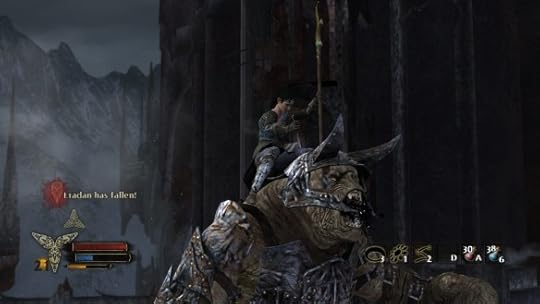 Chaos! Madness! Like a hug for your brain:
Chaos! Madness! Like a hug for your brain:
This month saw the release of Heroes of the Storm’s wackiest hero yet, Cho’Gall. Played by two players at once, he brings twice the power of any other hero, at the cost of leaving his team a man short.
His release was also unique, with a handful of players getting him for free, and everyone else able to unlock him by partying with an owner and piloting a head for a few games. Those who already had Cho’Gall could earn gold by spreading the “virus” to more players.
Motivated by the lure of extra gold — or perhaps feeling masochistic — I waded into the depths of the Heroes community to acquire Cho’Gall, share him with enough people to earn my 2K gold, and level both heads to level five.
To be fair, it wasn’t quite the horror show I expected. Gall is pretty much the same as playing a hat-build Abathur — which I do with some frequency — and Cho is mostly just a standard warrior with a guaranteed pocket DPS. And I only encountered one prick while grouping with people.
Definitely don’t plan to play any more Cho’Gall going forward, though.
Not sure how I feel about him on the whole. I’ve heard lots of people say he isn’t that competitive. My knee-jerk reaction was that he was very overpowered, but I’ve softened on that. Truth is probably somewhere in between.
 It really depends on the players. A bad Cho’Gall can ruin its team, but a good one is absolutely terrifying. Gall’s damage is absurd, and a good Cho will almost never die.
It really depends on the players. A bad Cho’Gall can ruin its team, but a good one is absolutely terrifying. Gall’s damage is absurd, and a good Cho will almost never die.
If nothing else, he’s damned annoying to play against. He’s a nightmare to deal with in the early game, and he has few obvious counters other than Leoric and to a lesser extent Kharazim (who must give up his better ultimate to serve as a counter).
Props to whoever came up with the idea of smashing together the names of his two players, though.
Towers of Doom:
Slightly more recently, Heroes also added its latest map, and this one is a home run. Towers of Doom is very much not like any other map added to date, and although it’s a bit early to say for sure, it might be my new favourite.
For a while, map design was starting to feel a little stale, with pretty much all map mechanics being variations on a few themes. Towers of Doom still has some familiar elements — fighting over altars is much like trying to capture tributes on Cursed Hollow — but there are some key differences.
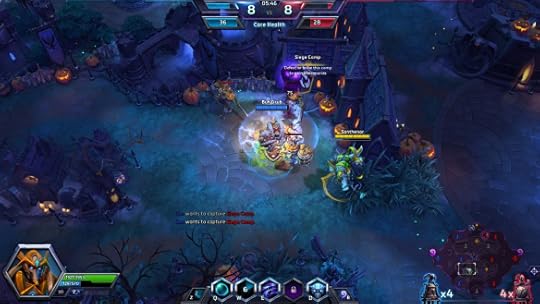 The mechanics of every map to date have been designed to help with pushing in some way. They help you destroy forts, and eventually the enemy core. Towers of Doom’s mechanic targets the core alone, and cores cannot be attacked by any other means.
The mechanics of every map to date have been designed to help with pushing in some way. They help you destroy forts, and eventually the enemy core. Towers of Doom’s mechanic targets the core alone, and cores cannot be attacked by any other means.
This is a refreshing change of pace in a lot of ways, but the most important difference is that winning a map objective does not generally give you any significant XP lead, so there’s much less snowballing than on any other map. This makes an already volatile game even more unpredictable, and comebacks can never be ruled out.
It’s also a very well-balanced map in terms of what roles are required. Most maps will tend to focus on team-fighting or on more traditional laning and pushing, but Towers of Doom has room for both. You need to win team fights over the altars, but destroying enemy bases to claim their bell towers is also very helpful.
The fact that towns don’t stay destroyed further combats snowballing and makes the map even more back and forth. If you’ve lost some forts, you can always reclaim them and/or steal some enemy forts.
I also love the idea of bringing back the announcers from previous maps — in this case Cursed Hollow and Haunted Mines — to battle against each other. Especially since those are both two very colourful and amusing characters.
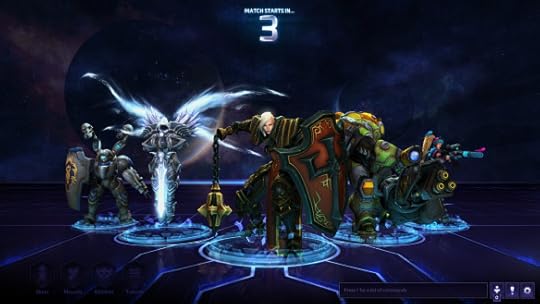 Though I must admit to being a little sad every time I don’t end up on the Raven Lord’s side. You’re cool, too, Grave Keeper, but the Raven Lord is just so suave.
Though I must admit to being a little sad every time I don’t end up on the Raven Lord’s side. You’re cool, too, Grave Keeper, but the Raven Lord is just so suave.
My only little complaint about all this is their decision to retire maps — at least temporarily — to prevent the map pool from becoming too bloated. I don’t understand why they don’t just let us blacklist one or more maps — that seems much better than the developers deciding for us what maps we can and can’t play on.
If I never see Dragon Shire again, it will be too soon.
Elder Scrolls Online: I’m still here
I continue to inch through Elder Scrolls Online at what I will generously call a snail’s pace, due to a combination of being frequently distracted by other things and the fact it’s a very slow game to progress in to begin with.
For the most part my opinion of it remains the same: It’s a solid but not stellar game. I remain somewhat unsure whether it will be something I stick with long term. It’s got a lot going for it, but I’ve yet to be blown away, and it has a lot of competition for my time.
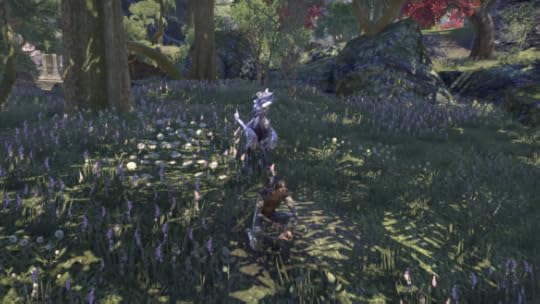 I have managed to finish the first zone, earn my mount, and unlock weapon swapping. The latter two things have had a very pronounced positive effect on my experience, which leads me to wonder why they take so damn long to unlock. The mount, in particular, took about twice as long to unlock as it would in your average MMO, and frankly I think the average wait time is a bit much.
I have managed to finish the first zone, earn my mount, and unlock weapon swapping. The latter two things have had a very pronounced positive effect on my experience, which leads me to wonder why they take so damn long to unlock. The mount, in particular, took about twice as long to unlock as it would in your average MMO, and frankly I think the average wait time is a bit much.
I’ve yet to see much evidence of the supposedly high quality storytelling this game boasts, but there was one quest that impressed. It was very disturbing, but very well done.
It involved what amounted to a residential school for Bosmer and Khajiit. Uncovering all the abuses suffered by the “students” was a pretty unnerving experience, especially given the history of my own nation. I did quite enjoy the opportunity to bring justice to the perpetrators in the end.
The whole “High Elves are racists” theme was prevalent throughout the Aldmeri starting zone, but it was mostly a very sanitized video game version of racism. This was the only quest to show the terrible results of bigotry, and it did so very effectively.
Also, as half-hearted as the whole racism story was, I also liked the game’s complete and utter disrespect for those who hold such attitudes, particularly Razum-dar’s insistence on simply calling them “idiots.”
I really hope I haven’t see the last of Razum-dar.

Generally I find this game’s writing fairly mediocre, but this is one of the more poignant pieces of dialogue I’ve seen in a video game.
I’ll also say I do enjoy this game’s eye for detail. I really like all these little stories that play out in your letters from the crafting hirelings (pro tip: Don’t **** with Pacrooti), and there are other small touches. The other day an NPC guard randomly complimented me on one of my heroic actions — which happened weeks ago in an entirely different zone.
War in the North: It’s okay, I guess?
Finally, I’ve also been working on getting through at least some of the backlog of games I’ve developed on my Steam account, starting with Lord of the Rings: War in the North.
I thought about doing a full review of it, but I don’t think I’ve got enough to say on the matter.
It’s not a terrible game, but I’m not sure I’d recommend it. It is, at best, adequate.
Despite an admiral effort at telling a new story in Middle-Earth while staying true to the books, there just isn’t much in the way of a story, nor are any of the characters developed enough to be interesting. Mostly it’s just an excuse to wander around decapitating Orcs.
On the plus side, you get to wander around decapitating Orcs.
The combat is mostly quite visceral and fun, but it can also get rather frustrating in certain spots. A lot of high level enemies pretty much just chain-stun you endlessly, which gets incredibly aggravating after a while.
 Ultimately the main thing I liked was simply the character I chose to play as: an Elven battle-mage. I do love playing a spell caster who can wade into the fray and get their hands dirty. Plus she was voiced by Laura Bailey, which is always plus.
Ultimately the main thing I liked was simply the character I chose to play as: an Elven battle-mage. I do love playing a spell caster who can wade into the fray and get their hands dirty. Plus she was voiced by Laura Bailey, which is always plus.
I’ll also give the game some credit for making its female armour actual armour.
Filed under: Games Tagged: Elder Scrolls, fantasy, Heroes of the Storm, Lord of the Rings, sci-fi, The Elder Scrolls Online, video games








November 25, 2015
What I Learned from my Second Play Through of Dragon Age: Inquisition
You may remember a few months ago I was so enamored with Dragon Age: Inquisition’s Trespasser DLC that it inspired me to do something previously unthinkable and start a second play through, this time as a Qunari rogue.
 In the process, I learned a few interesting things about the story, characters, and game mechanics, and now I share that knowledge with you.
In the process, I learned a few interesting things about the story, characters, and game mechanics, and now I share that knowledge with you.
Warning: Here be spoilers.
Cassandra isn’t so bad after all:
I was not a fan of Cassandra on my first play through. I did not hate her as I do Vivienne, but I certainly liked her a lot less than any of the other companions. She came across as almost bipolar, seemingly hating my inquisitor’s guts one moment and lavishing praise on me the next.
However, on my second run through the game, my decisions led to my having a much higher approval rating with her, and as a result, I saw a lot of new (to me) and altered scenes that put her in a different light.
It’s not even so much a case of her seeming more likable, as simply more human. I realized there was a person underneath all that armour, both literal and metaphorical. I saw that was more to her than irritability and judgement.
 She’ll never be my favourite character, but I do feel a certain sort of camaraderie with her now.
She’ll never be my favourite character, but I do feel a certain sort of camaraderie with her now.
…Yeah, I admit it, it was mostly just the scene where I caught her reading Varric’s book.
That was sublime.
Dorian is cool, but Sera is better:
One of my main reasons for doing a second play through was because I wanted to see Dorian’s romance arc. I do not regret doing so, but I’ll tell you now: I liked romancing Sera a lot better.
Now, don’t get me wrong. Dorian is great. I’ve found him a hilarious and lovable character from the moment he first appeared, and that opinion has not changed since. He is second only to Sera and Solas when it comes to my favourite Inquisition characters, and only by the very slimmest of margins.
But perhaps that’s the problem.
Dorian’s romance is sweet, easy to do, and entirely pleasant from beginning to end. It’s a fairy tale — albeit a fairy tale with an unusually high quantity of sarcasm and naked dudes.
 There’s no drama or challenge, and it doesn’t do much to flesh out Dorian’s character. It turns out he’s pretty much exactly who he appears to be. For me, the main appeal of an in-game romance is to see another side to a character, to understand them in greater depth, but Dorian’s romance offers little illumination. He’s the same delightful ball of snark and idealism throughout.
There’s no drama or challenge, and it doesn’t do much to flesh out Dorian’s character. It turns out he’s pretty much exactly who he appears to be. For me, the main appeal of an in-game romance is to see another side to a character, to understand them in greater depth, but Dorian’s romance offers little illumination. He’s the same delightful ball of snark and idealism throughout.
The conclusion of the romance in Trespasser is also fairly underwhelming. I don’t hate it as much as some I’ve seen, but it’s definitely less than stellar. Feels like they didn’t put much effort into it.
Sera’s romance, on the other hand, was a bigger challenge than some StarCraft II missions on brutal. Granted, I made it hard on myself by being a Dalish Keeper, but even so, Sera is a challenging character to wrap your head around. Even at the most basic level, deciphering the foul-mouthed, rapid fire word salad that is her dialogue is pretty much a full-time job.
Similarly, Sera is in many ways a less likable character than Dorian. She’s loud, she’s crude, she’s unpredictable and easy to offend, and she’s at least a little racist.
Yet all those things also make it so much more rewarding when you finally do win her over and begin to peel back the layers of her character.
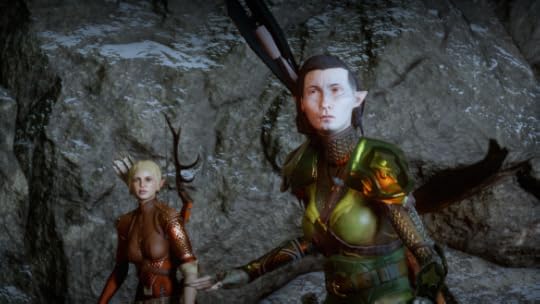 Sera seems so basic at first, yet she is one of the most deep characters Bioware has produced, and that’s saying a lot. For all her many flaws, she has some incredibly admiral traits, and the balance between those two sides of her is fascinating to see play out. And in the end, it does seem as though the better parts of her nature slowly win out.
Sera seems so basic at first, yet she is one of the most deep characters Bioware has produced, and that’s saying a lot. For all her many flaws, she has some incredibly admiral traits, and the balance between those two sides of her is fascinating to see play out. And in the end, it does seem as though the better parts of her nature slowly win out.
So as much as I truly do love Dorian as a character, Sera’s romance arc is simply so much more layered and rewarding.
Now, granted, it turns out a lot of the scenes I thought were part of Sera’s romance were not, so perhaps that has skewed my opinion, but I still think Sera has the edge.
As an aside, I was interested to discover much of Sera’s personal improvement in Trespasser happens even if you don’t romance her. I didn’t expect that.
Cole is happier as a spirit:
When I did Cole’s quest on my first play through, I chose to nudge him towards being more like a human. In retrospect, this seems an incredibly odd decision.
My inquisitor was a Dalish Keeper, and she tended to agree with Solas on nearly everything. Pushing Cole away from being a spirit seems terribly out of character for her.
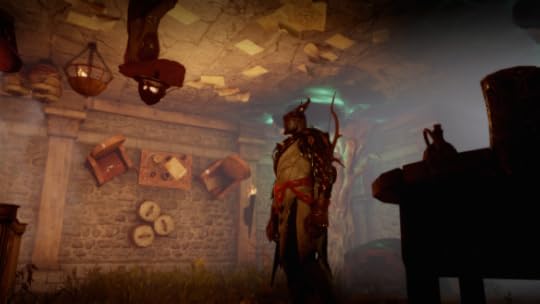 All I can say is that it seemed like the “right” decision. I think we’re all so used to the “Tin Man wants a heart” style of story that we just follow it without thinking. Or at least I did.
All I can say is that it seemed like the “right” decision. I think we’re all so used to the “Tin Man wants a heart” style of story that we just follow it without thinking. Or at least I did.
However, for completionism’s sake, I took the opposite path on my Qunari, and I came to regret my original decision.
Cole is so happy as a spirit, so free. He’s able to cast off all his pain, and in so doing, he’s able to do so much good for everyone around him. He becomes a real embodiment of compassion and purity.
In fairness, he seemed pretty content as a human, too. I’m not sure there’s a wrong choice here. But to my eye he does seem more at peace as a spirit, and I think there’s something to be said for not forcing him to be something he’s not. Namely, human.
I’d rather accept Cole for what he truly is. It may be alien and hard to understand, but I think there’s a certain beauty to his true self, as well.
Flirting with Cullen as a male Qunari is wonderful:
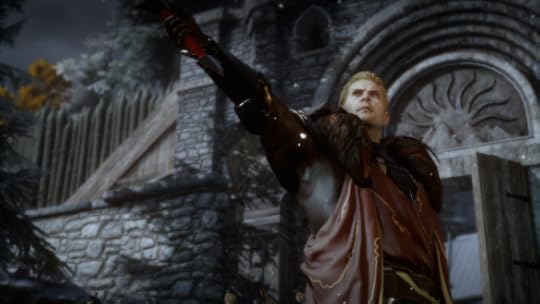 Seriously, try it. I don’t know what’s better: Cullen’s spectacular discomfort, or the absolutely filthy looks my Qunari gives him.
Seriously, try it. I don’t know what’s better: Cullen’s spectacular discomfort, or the absolutely filthy looks my Qunari gives him.
Really wish I’d thought to take a screenshot of that.
Horn of valor is awesome:
This is something I noticed on my first play through, but the second time really confirmed it. You want all your warriors to be using the horn of valor ability.
It’s a pretty nice buff on its own, but add the upgrade that makes it grant guard to the entire party, and it becomes incredible. Add a barrier mage and enjoy your unkillable party.
You can skip an incredible amount:
My feelings on Inquisition’s mountains of busywork are known by now, so this time around, I decided to skip nearly everything aside from the main storyline, companion quests, and whatever random stuff I happened to stumble across along the way. There were some zones I never entered at all.
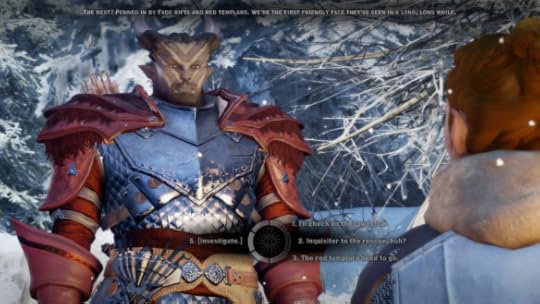 And I can’t say it had a particularly negative impact on my experience. I was still past level twenty by the end, I still had very good gear (thanks to the Golden Nug and crafting schematics carried over from my first character, admittedly), and the game still took me about sixty hours to finish, which is still incredibly long for a single player title.
And I can’t say it had a particularly negative impact on my experience. I was still past level twenty by the end, I still had very good gear (thanks to the Golden Nug and crafting schematics carried over from my first character, admittedly), and the game still took me about sixty hours to finish, which is still incredibly long for a single player title.
Shows you how unnecessary all the other junk ultimately is.
Requisitions are entirely useless:
This is something else I kind of learned on the first time through, but the second time confirmed it.
Even skipping most of the optional content, I still had more than enough power to do everything I wanted to do. Power rains from the sky in this game, and it’s completely worthless once you have enough to unlock everything.
All requisitions do is eat up your hard-earned crafting materials for no good reason. They’re a trap; don’t bother with them.
Calpernia is cool:
 I loathe the Templars and all they stand for. However, in the interest of completionism, I did decide to side with them on this play through. This didn’t do much to change my opinion of the Templars, but it did have one silver lining, and her name is Calpernia.
I loathe the Templars and all they stand for. However, in the interest of completionism, I did decide to side with them on this play through. This didn’t do much to change my opinion of the Templars, but it did have one silver lining, and her name is Calpernia.
Calpernia is a most intriguing character. Misguided idealists are always interesting, and I thought it was a great twist to have someone so noble working for Corypheus. Here is someone who has experienced firsthand the very worst her country has to offer, but she still sees the good in it, and she still wants to redeem it.
That’s pretty amazing.
I only wish she had been given a bigger role. Like Corypheus himself, she feels like a waste of potential.
It’s extremely unlikely, but I would love to see her have a role in the next game. Maybe even as a full companion.
And finally…
This game is still buggy as all Hell.
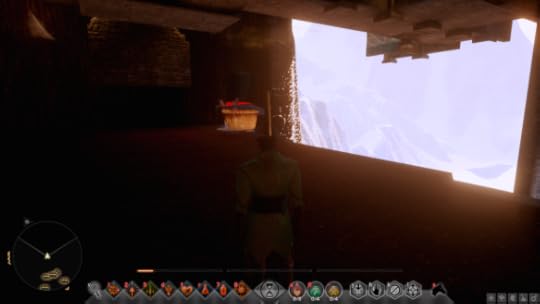
Filed under: Games Tagged: Dragon Age, fantasy








November 22, 2015
Tyler’s Big Book of TSW Theories
After going on the backburner for a few months, The Park and Halloween got my interest in The Secret World revved up to a fevered pitch once again. After yet another night of staying up past midnight reading theories on the lore forums, it occurred to me I’ve never much talked about my own theories surrounding the many mysteries of the Secret World.
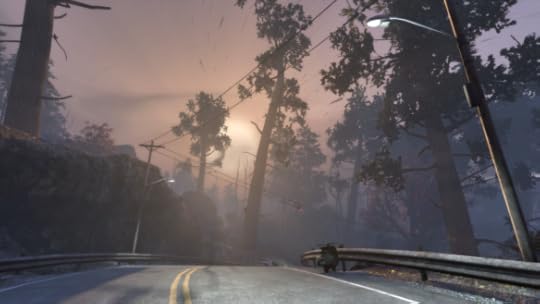 I thought it might be interesting to have a public, written record of them so that I can either crow when they turn out to be right, or laugh at how hilariously wrong they turned out to be.
I thought it might be interesting to have a public, written record of them so that I can either crow when they turn out to be right, or laugh at how hilariously wrong they turned out to be.
Be aware that this entire post will contain massive spoilers for the entirety of the TSW mythos to date, including The Park.
Cassandra King is a descendant of King Arthur:
The general instinct of most people in the TSW community seems to be to just assume everyone is a god or a mythological figure in disguise. Most people tend to be of the opinion that Cassandra King is someone from Greek mythology, perhaps the Trojan Cassandra. I’ve also heard her hypothesized to be Artemis, Aphrodite, and a bevy of other ancient fertility goddesses.
I really don’t like the idea of Cassie being an immortal, though. The whole appeal of her story is that she’s an ordinary girl — well, as ordinary as a precocious self-taught sorceress can be, anyway — who managed to outsmart the big three secret societies and the very god of deceivers.
There isn’t really a lot to support the idea, either. Just her first name and her “Do you have any idea who I am” line.
 I prefer to focus on the significance of Cassie’s surname, and in so doing, I find a way to explain her importance while mostly maintaining her hook as a “normal” who beat the greats of the Secret World.
I prefer to focus on the significance of Cassie’s surname, and in so doing, I find a way to explain her importance while mostly maintaining her hook as a “normal” who beat the greats of the Secret World.
What are the odds that a woman named King wound up stealing Excalibur?
I think Cassie is a direct descendant of King Arthur. This is sort of the best of both worlds. It more or less maintains her identity as a normal person who made her way to greatness — Arthur’s line having theoretically languished in obscurity for centuries — while also explaining the line, “Do you have any idea who I am, or what I am about to become?”
If she were already a goddess, what is left for her to become? But if she is an ordinary person from an extraordinary line, regaining Excalibur could make her truly a force to be reckoned with.
This could also explain what she’s doing in Scotland. Perhaps Excalibur will grant her access to further treasures or powers that are the legacy of her family, which have lain hidden in the British Isles for centuries, waiting for the true heir to the king to return.
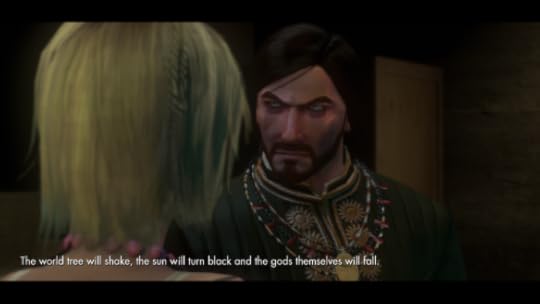 Finally, depending on which version of things we follow, this could also make Cassie a relative or descendant of Morgan le Fay, which would explain her talent as a witch.
Finally, depending on which version of things we follow, this could also make Cassie a relative or descendant of Morgan le Fay, which would explain her talent as a witch.
There are many Hells:
This one started when I first stepped into the Niflheim holiday dungeon. It was clearly part of the Hell Dimensions, but also totally unlike the Hell dungeons we had explored before.
Then it occurred to me that it’s always been the Hell Dimensions, plural. And there are a lot of references in Tokyo to “the Thousand Hells.”
So I don’t think Hell is a single place. I think there are many Hells, and the one we explored with Wicker was just one of them. Niflheim is another. Who knows how many more there might be?
Emma Smith might be Lorraine Maillard’s daughter:
I’m offering this as an uncertainty because there’s a lot of things about this that just doesn’t add up, but it’s too intriguing not to mention.
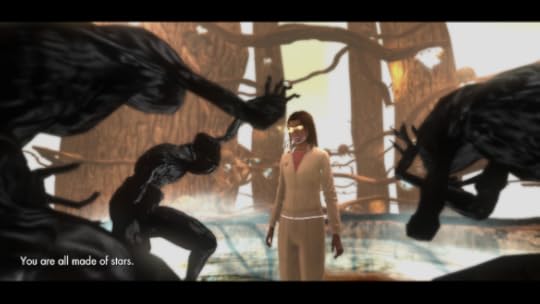 The Park is full of subtle nods to TSW, but one that totally passed me by on the first play through has the potential to be a major revelation. Don’s letter to Lorraine mentions that he wanted to name their child Callum if a boy, or Emma if a girl.
The Park is full of subtle nods to TSW, but one that totally passed me by on the first play through has the potential to be a major revelation. Don’s letter to Lorraine mentions that he wanted to name their child Callum if a boy, or Emma if a girl.
I don’t believe in coincidence where TSW is concerned. I’m sure Joel Bylos knew what he was doing when he put that in there. It might just be a deviously clever red herring, but it’s definitely meant to make us wonder if Emma Smith might somehow be Lorraine’s long lost daughter.
If that’s the case, there are basically two possible scenarios.
One is that Emma is Callum’s twin brother. Perhaps, for whatever reason, when Lorraine was released from the mental asylum, the authorities only gave her back Callum. Perhaps Emma was even abducted by the Orochi Group or one of the secret societies. Lorraine, already somewhat unhinged at this point, repressed all memory of Emma’s existence.
In this scenario, Emma’s powers could be explained as the result of Lorraine’s latent sensitivity to the occult and/or the influence of the dark power in the Atlantic Island Park.
The main problem with this theory is that the timeline doesn’t add up at all. Callum was born thirty years ago, but Emma looks to be around eight years old in TSW. That said, she’s definitely not an ordinary girl, so perhaps she doesn’t age normally.
 The other possibility is that Lorraine had Emma much later, after the Council of Venice implanted the bee in her. Being the child of a bee, especially a unique artificially created bee, could definitely explain where Emma got her power from.
The other possibility is that Lorraine had Emma much later, after the Council of Venice implanted the bee in her. Being the child of a bee, especially a unique artificially created bee, could definitely explain where Emma got her power from.
The main issue with this theory is that it’s a bit hard to believe Lorraine would have another child after what happened with Callum, but she is pretty unstable, so her behaviour is difficult to predict.
Both possibilities have the issue that Emma seems to be British, and Lorraine definitely isn’t. This could, however, be explained by Emma not being raised by her biological mother. Certainly no one — not even Lorraine if she was sufficiently lucid at the time — would think letting Lorraine try to raise another child could be a good idea.
The one final flaw is that Emma has made clear her real name is Anima, not Emma. But perhaps this is her own invention, and the name Emma came first?
It’s all a big long shot, for sure. But it’s intriguing.
Consider that the story of Lorraine and her son is constantly being compared to Hansel and Gretel, but if Callum is Hansel, who’s Gretel? And is it a coincidence that both Callum and Emma have a teddy bear as a central part of their story?
Daimon Kiyota is not a god:
 This isn’t so much a theory as a counter to a theory, but I’ll include it anyway.
This isn’t so much a theory as a counter to a theory, but I’ll include it anyway.
Daimon Kiyota is another character widely speculated to be a mythological figure in disguise, likely a Shinto deity, but I personally don’t buy it.
As with Cassie, a large part of the appeal of Daimon’s character is that he is (supposedly) a normal person who has managed to make himself a force to be reckoned with in the world of the occult. This is all but confirmed by the turn-in text for The Seven Silences.
Now, I do think Daimon is at this point fairly extraordinary. I’m pretty sure his “father,” who visited New York, was really just him, and if that’s true, that means Daimon hasn’t aged since the 1920s. I’m pretty sure he’s got some funky powers going on, possibly related to the pachinko machine (which wasn’t always a pachinko machine, but it always was). I think Daimon started out human, but he may not be anymore.
But a god? No, I don’t think so.
The woman who came between the brothers in Babel was Lilith:
Pretty much that. We know that the secret society that would become both the Templars and the Phoenicians was ruled by two brothers from the Tower of Babel, but that a woman came between them, sundering their bond and the society they ruled.
 That sure sounds like something Lilith would do, and we don’t have a lot of other strong candidates.
That sure sounds like something Lilith would do, and we don’t have a lot of other strong candidates.
Interestingly, this is another thing that some people want to pin on the supposedly divine Cassandra, but I really think Lilith is our better candidate. It’s not really so much different from what she pulled with Callisto, Mara, and Dracula.
* * *
What say you? Does this tinfoil hat make me look fat? Feel free to add your own theories in the comments.
Filed under: Games Tagged: fantasy, The Secret World, tinfoil








November 19, 2015
WoW: On Legendary Items and Grinding
In the past few weeks, I have completed not one, not two, but three separate legendary quest chains in World of Warcraft. My rogue has claimed both the Band of the Archmage and the Fangs of the Father, while my warlock is now the proud owner of Dragonwrath, Tarecgosa’s Rest.
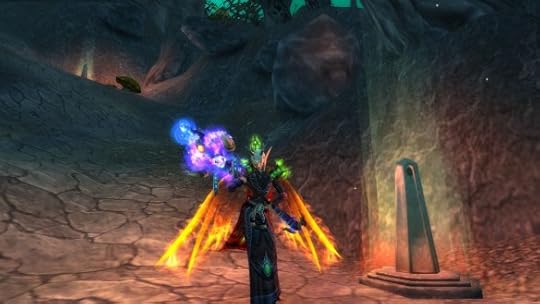 I now present to you my thoughts on the three quest chains, as well as on the process of grinding for high level rewards in general.
I now present to you my thoughts on the three quest chains, as well as on the process of grinding for high level rewards in general.
Fangs of the Father:
Man, this was a journey. I wonder if anyone around today has been reading this blog long enough to remember Operation: Payoff?
Either way, this is a process that began all the way back in patch 4.3. The quest lay forgotten in my log for much of the final days of Cataclysm and nearly all of Mists of Pandaria, until I could finally solo Dragon Soul. Then it was a matter of some weeks of grinding to upgrade my daggers to their ultimate, legendary state.
On the whole, this was my favourite of the three legendary chains. Wrathion is a very entertaining character, and Dragon Soul remains one of my all-time favourite raids. While I did get a bit sick of it by the end, mostly I enjoyed revisiting it.
By legendary standards, the quest didn’t feel like too much of a grind, either. Dragon Soul is pretty quick to breeze through, especially as a rogue, and there aren’t too many hoops to jump through.
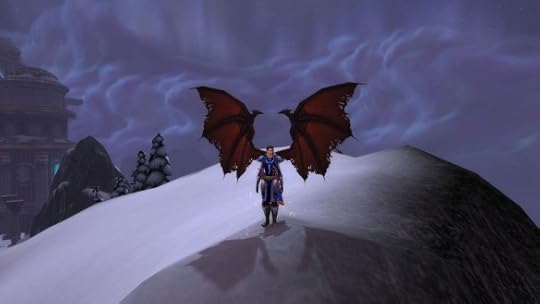 My only major complaint is that the daggers actually look less cool with each upgrade level. The legendary versions are downright hideous. Shame you can’t transmog legendary items.
My only major complaint is that the daggers actually look less cool with each upgrade level. The legendary versions are downright hideous. Shame you can’t transmog legendary items.
Band of the Archmage:
Conversely, this was the least interesting of the three legendary chains. Khadgar is amusing, and getting to interact with Garona — albeit an alternate universe version — was somewhat cool, but on the whole the story wasn’t that interesting.
It certainly pales in comparison to the excellent storytelling present in the quest line for the Shroud of the Celestials back in Pandaria.
It’s funny because I seem to remember Blizzard saying that they liked the epic storytelling and solo changes of Shroud of the Celestials, but wanted to de-emphasize the repetitive grinding for the Warlords of Draenor chain, but that’s the exact opposite of what happened.
In WoD, it was basically nothing but grinding. Oh, we got a few story moments and solo boss fights, but they were all quite brief, easy, and generally underwhelming. Mostly it was just a lot of endless raid grinding.
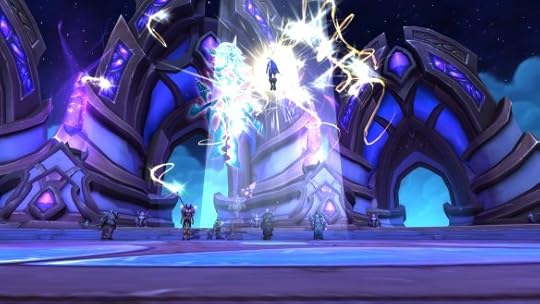 The overall chain actually didn’t take me all that long thanks to the garrison, catch-up mechanics added over the course of the expansion, and the short length of WoD as a whole, but it still felt like a massive slog to me.
The overall chain actually didn’t take me all that long thanks to the garrison, catch-up mechanics added over the course of the expansion, and the short length of WoD as a whole, but it still felt like a massive slog to me.
I considered giving up many times. Only a desire to have not wasted the effort already put in and my own perverse completionism kept me going on.
It also needs to be said that the legendary ring itself is a great disappointment. The “awesome effect” we were promised turned out to be an ugly reskin of a disc priest bubble, and you can’t even control your own ring in a group because they’re all tied to everyone else in your raid. And while solo, the ring’s effect is quite weak.
Dragonwrath, Tarecgosa’s Rest:
This one I have more mixed feelings on.
On the one hand, the story is pretty good. I’m still not entirely clear how or why Kalecgos opted to fuse a dead Dragon’s soul on to me, but otherwise it’s a nice chapter of the Blue Dragonflight’s history. Some of the challenges in between the more grindy phases were also pretty fun. Loved the revamped Nexus.
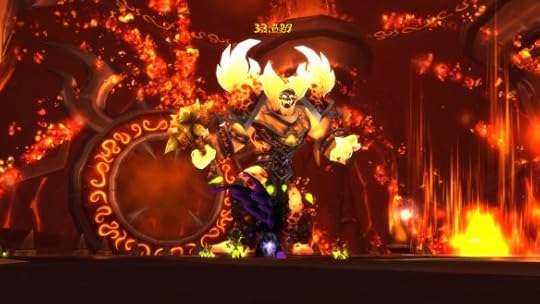 I also got to spend a lot of time in Firelands, which is a raid I quite like and regret not seeing more of back in Cataclysm.
I also got to spend a lot of time in Firelands, which is a raid I quite like and regret not seeing more of back in Cataclysm.
But by “a lot” I mean “ultimately too much.”
Even by legendary standards, this quest chain was a horrible grind. Three separate multi-week stages involving repeating the same raid over and again is just brutal. I may like Firelands, but by the end I just utterly fed up with the place.
The staff is pretty cool, and I like the mount effect. Shame it’s tied to the staff and not just something you can store in your mount journal and add to your action bar, though.
On grinding:
Unfortunately, after all this, I am not left with a sense of accomplishment, nor much joy in what I’ve gained. Mostly I’m just relieved it’s over.
I am reminded of why I almost never pursue long term or difficult goals in MMOs. The reward almost never matches up with the amount of effort needed to get there.
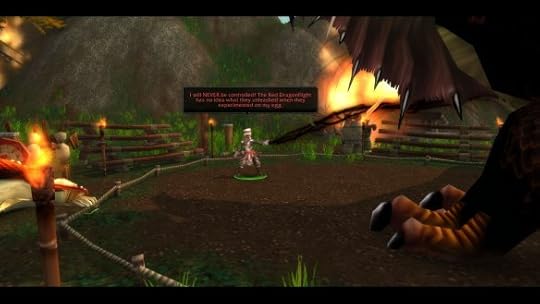 I have to wonder: Is grinding ever worth it?
I have to wonder: Is grinding ever worth it?
I’m not talking about spending lots of time doing something you enjoy anyway. I have no regrets over getting 100% ability wheel completion in The Secret World because I achieved that simply by playing the game as I normally would.
No, I’m talking about forcing yourself through content long after you’ve stopped enjoying it — if you ever did — just for the reward at the end. In theory, this is supposed to give one a warm sense of accomplishment, but it doesn’t seem to work out that way. Whatever sense of accomplishment you might have always ends up being dwarfed by the vague unease over how many hours of your life you’ve wasted doing mindless, repetitive tasks for the promise of a few pixels.
I mean, I am glad I did these chains… but more out of a obsessive need to not feel like I’ve missed anything than because the experience was so special. I do like having the items, and every chain had at least a few moments I truly enjoyed, but in the end, I’m not sure any of them are worth all the time and headache.
If nothing else, at least I can enjoy being a god in timewalking dungeons. With her Fangs, Shroud, and Band, my rogue can sometimes end up doing as much or more damage than all the other players in the party combined.
So that’s fun.
Filed under: Games Tagged: fantasy, Warcraft, World of Warcraft








November 16, 2015
Review: StarCraft II: Legacy of the Void
It’s been a long time coming.
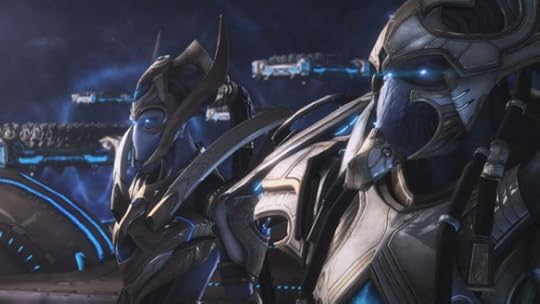 As StarCraft fans, we waited over ten years for a follow-up to Brood War, and as a Protoss fan, I had to wait even longer for the expansion that would at last put my favourite race in the spotlight.
As StarCraft fans, we waited over ten years for a follow-up to Brood War, and as a Protoss fan, I had to wait even longer for the expansion that would at last put my favourite race in the spotlight.
It’s been a long time coming, but to paraphrase that most quintessential Canadian band, it’s well worth the wait.
The End War:
I enjoyed the first two installments of StarCraft II. Wings of Liberty had some flaws, but mostly it was a strong story that I enjoyed. Heart of the Swarm was somewhat of a disappointment, but even it had many highlights.
Legacy of the Void vastly outstrips both its predecessors. The fact I am a Protoss fan may bias me, but I think there’s a lot more to it than that.
LotV’s campaign begins with the full might of the Daelaam Protoss united at last, ready to retake Aiur from the Zerg and reclaim the pride and tradition of the Firstborn. But in remarkably little time, things go terribly wrong.
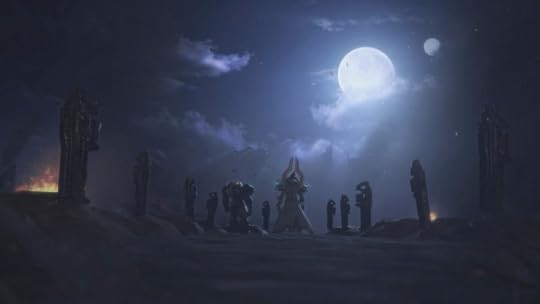 Thus begins the End War, the final conflict with the void god Amon. Whereas the last two installments spread themselves thin over many stories that had at best only tangential relationships with one another, LotV focuses entirely on the conflict with Amon, and while it can at times feel a little abrupt or rushed, mostly it does an excellent job of selling the idea of a universe teetering on the brink of destruction.
Thus begins the End War, the final conflict with the void god Amon. Whereas the last two installments spread themselves thin over many stories that had at best only tangential relationships with one another, LotV focuses entirely on the conflict with Amon, and while it can at times feel a little abrupt or rushed, mostly it does an excellent job of selling the idea of a universe teetering on the brink of destruction.
Over the course of the campaign, Artanis must bring together the disparate tribes of Protoss, some familiar and some new in LotV, to forge an army capable of facing Amon. Something that I’ve liked about the Protoss from the start is that although they are a very alien race, they are also very diverse, with many differing viewpoints and philosophies within their ranks, and LotV builds on that well, further deepening the Protoss culture even as it goes through great changes.
Legacy of the Void is in many ways a story about multiculturalism and the strength it brings. Although its handling is at times somewhat inelegant, I think this is a very noble message to send, and quite relevant in this day and age.
The story doesn’t end with Legacy of the Void’s main campaign, though. There is also an epilogue campaign consisting of three missions that give you the chance to play as each race once more.
Actually, calling it an “epilogue” is perhaps a bit misleading, as it is every bit as epic and intense as the main campaign, and it at last brings a close to all of the story and character arcs that began all the way back in the 90s.
 I was sufficiently impressed by that ending that I struggle to think of what to say about it. It was awe-inspiring. It was emotional. Most of all, it was immensely satisfying.
I was sufficiently impressed by that ending that I struggle to think of what to say about it. It was awe-inspiring. It was emotional. Most of all, it was immensely satisfying.
The mechanics of storytelling were also better than ever this time around. Cinematics are as ever a feast for the eyes, and they are both incredibly numerous and more seamlessly integrated than ever before. At times, cinematics even play in the middle of missions, shifting from gameplay to cutscene and back with total smoothness. Very impressive.
That’s not to say the entire campaign was perfect. I can poke some holes here or there.
By far my biggest complaint is how small a role was given to Executor Selendis. Blizzard has spent years dropping hints that she was going to be a big deal in the coming story, but in actuality she appears in only a handful of missions, and then in a relatively small role.
I also had issues with some of the ways the Protoss culture changed over the course of the campaign, including but not limited to the fact they tend to happen a little quickly and/or with poorly explained reasoning.
Still, on the whole, it was definitely the best part of the StarCraft II saga, and possibly the best installment of the franchise to date. Definitely a worthy end.
 …Except it’s not the end; story DLC is already on the way, which is now giving me mixed feelings. On the one hand, yay, more StarCraft. On the other, there’s pretty much nowhere to go from here but down.
…Except it’s not the end; story DLC is already on the way, which is now giving me mixed feelings. On the one hand, yay, more StarCraft. On the other, there’s pretty much nowhere to go from here but down.
RTS done right:
From a gameplay perspective, Legacy of the Void’s campaign is also a step up from its predecessors.
Wings of Liberty and Heart of the Swarm had excellent mission design, bringing a breath of fresh air to the sometimes stale RTS genre, but they relied too heavily on missions with some sort of time limit. Every level was a sprint the finish, and it became exhausting after a while.
LotV still has some missions like that, but they’re not as omnipresent. There are a lot more missions that allow you to take your time, plan your strategy, explore the map, and gradually fight your way to victory. There’s still a lot of fresh ideas, but it also brings back some of the long, epic battles of more old school RTS games. It’s the best of both worlds.
I was quite disappointed to not see the return of hero units as seen in Heart of the Swarm, but being able to call upon the abilities of the Spear of Adun is a decent substitute. They’re similar to the god powers of Age of Mythology, but with the advantage of not being limited-use.
 I also greatly enjoyed the mechanic for customizing units this time. Instead of upgrades in the traditional sense, each unit has three variations based on the various Protoss factions, each with different advantages. You can swap between different variations between missions, so there’s a lot of encouragement to experiment and tailor your forces to a specific challenge.
I also greatly enjoyed the mechanic for customizing units this time. Instead of upgrades in the traditional sense, each unit has three variations based on the various Protoss factions, each with different advantages. You can swap between different variations between missions, so there’s a lot of encouragement to experiment and tailor your forces to a specific challenge.
If I have a complaint about the campaign’s design, it’s that it takes a little too long to unlock more advanced units and abilities early on. It makes a certain degree of sense from a story perspective, but after two games, I’m kind of over the “slowly build up your forces from nothing” angle. Let’s cut to the chase, shall we?
Multiplayer:
I dipped my toes into competitive play for the first time in years, but I didn’t stay long enough to get a comprehensive view of what Legacy of the Void has brought to the table in that regard.
I will say that I think the economic changes are very good. They cut down on a lot of the tedious downtime at the start of a match and allow you to get to the action more quickly. If anything, they don’t go far enough — there’s still too much economic busywork in this game.
But mainly what I learned is that I’m still terrible at competitive StarCraft II, and still lack the emotional fortitude to deal with the high stress of it all. Especially now that the game is faster than ever.
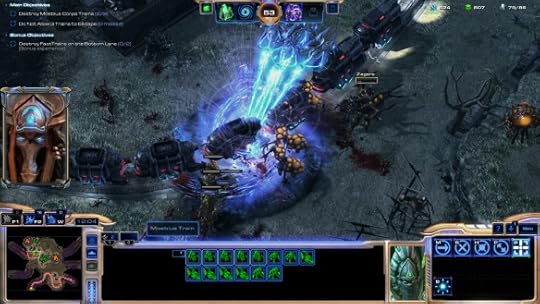 To their credit, Blizzard has put some effort into opening avenues of multiplayer that are not so intense. Archon mode allows two players to work in tandem, splitting the responsibilities of running a single army. Cool idea, but to me it just sounds like you’d constantly be stepping on each other’s toes. Doesn’t appeal to me.
To their credit, Blizzard has put some effort into opening avenues of multiplayer that are not so intense. Archon mode allows two players to work in tandem, splitting the responsibilities of running a single army. Cool idea, but to me it just sounds like you’d constantly be stepping on each other’s toes. Doesn’t appeal to me.
More interesting to me are the co-op missions, which allow two players to work together against the AI using powerful units and abilities from the campaign. These don’t replicate the campaign experience as well as I was hoping, and I feel they’re best played with a friend, but they’re still pretty fun, even if you’re playing with a stranger.
On the whole, I’d rate co-op missions the most positive addition to SC2’s multiplayer.
* * *
With a stellar campaign and some solid changes to multiplayer, the final installment of the StarCraft II trilogy is also by far the best. This is why I’m such a big Blizzard fan; they may screw up a lot, but when they get it right, they get it right.
Overall rating: 9.5/10 Possibly the best Blizzard game since Warcraft III.
Filed under: Games, Reviews Tagged: review, sci-fi, Starcraft











